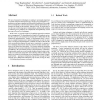Free Online Productivity Tools
i2Speak
i2Symbol
i2OCR
iTex2Img
iWeb2Print
iWeb2Shot
i2Type
iPdf2Split
iPdf2Merge
i2Bopomofo
i2Arabic
i2Style
i2Image
i2PDF
iLatex2Rtf
Sci2ools
ICCAD
2001
IEEE
2001
IEEE
Transient Power Management Through High Level Synthesis
The use of nanometer technologies is making it increasingly important to consider transient characteristics of a circuit’s power dissipation (e.g., peak power, and power gradient or differential) in addition to its average power consumption. Current transient power analysis and reduction approaches are mostly at the transistor- and logic-levels. We argue that, as was the case with average power minimization, architectural solutions to transient power problems can complement and significantly extend the scope of lower-level techniques. In this work, we present a high-level synthesis approach to transient power management. We demonstrate how high-level synthesis can impact the cycle-by-cycle peak power and peak power differential for the synthesized implementation. Further, we demonstrate that it is necessary to consider transient power metrics judiciously in order to minimize or avoid area and performance overheads. In order to alleviate the limits on parallelism imposed by peak pow...
Hardware | ICCAD 2001 | Transient Power | Transient Power Characteristics | Transient Power Management |
| Added | 17 Mar 2010 |
| Updated | 17 Mar 2010 |
| Type | Conference |
| Year | 2001 |
| Where | ICCAD |
| Authors | Vijay Raghunathan, Srivaths Ravi, Anand Raghunathan, Ganesh Lakshminarayana |
Comments (0)

